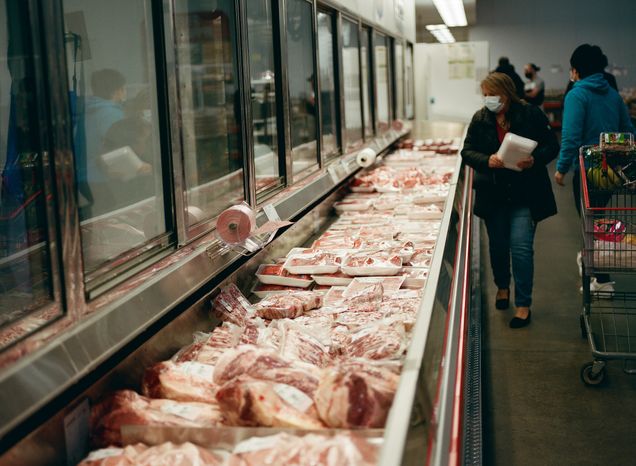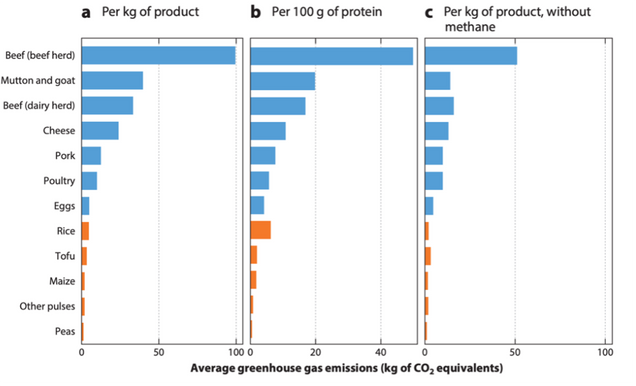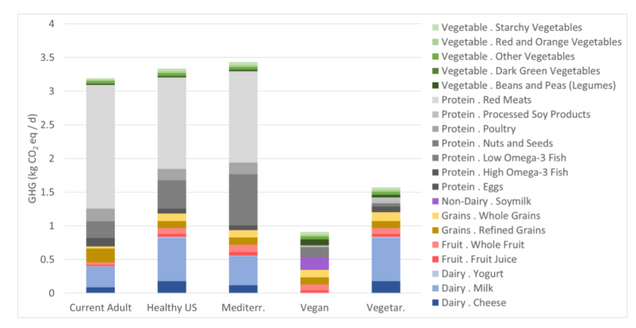An Economic Assessment of US Meat Production: Market Failure and Policy Solutions

By Eric Christine
Over the past decade, the US meat market—driven largely by cattle and swine—has been the single largest contributor to agricultural cash receipts nationwide. Yet beneath its profitability lies an industry characterized by oligopoly, asymmetric information and staggering environmental and health costs to society. This article discusses these impacts and proposes policy solutions to minimize the social costs of US meat production.
Current Market Dynamics
Meat production is a vital aspect of the US agricultural economy. The modern meat-packing industry—dominated by four large firms—has become more vertically integrated than ever before, leading to a virtual monopoly on US meat production. As profits remain high, the increase in large, industrialized farms for raising cattle and swine has resulted in the decline of regional and local farms.
On the consumer side, retail sales of meat products in the US reached record highs in 2024. Demand remains high and the perception of meat among US consumers remains relatively positive despite the numerous environmental and health costs. Food availability data indicates that per capita red meat and poultry consumption is approximately 226 pounds (see Figure 1). This means that the average American is consuming nearly 70 ounces of meat and poultry every week—over two and a half times the amount recommended by current national dietary guidelines.
While public awareness regarding the benefits of plant-based diets and the harms of industrial meat production has risen in recent years, there remains a disconnect between consumer perceptions and the true environmental impacts of meat production—resulting in informational barriers to socially optimal choices. Public health practitioners, economists and policymakers must work to synthesize the available evidence to raise awareness and implement policies to optimize the US food production system.
Figure 1: Annual Per Capita Availability of Beef, Pork, Broilers, Turkeys and Eggs, 2015-2026

Source: USDA Economic Research Service 2025.
Note: Per capita meat availability is a proxy measure for consumption and does not reflect indirect consumer use such as pet food use or food waste
What is Market Failure in Economics?
In economics, market failure is a condition that arises when the forces of supply and demand, operating in a free market, lead to an inefficient allocation of resources that does not maximize social welfare. One of the most common and significant causes of market failure is the existence of externalities. Externalities are any impacts, positive or negative, that the production or consumption of a good or service has on a third party—an entity other than the producers and consumers in the market.
The US market for meat products demonstrates a clear and multifaceted case of market failure due to the presence of numerous unpriced negative externalities, including the health and environmental costs of meat production and consumption. These externalities create a substantial divergence between the market price of meat and its true cost to society.
Environmental Impact of Meat Production
Beef has the largest environmental footprint of any food produced globally. Livestock require large amounts of land, water and resources while contributing to food loss and fossil fuel use. Concentrated animal feeding operations (CAFOs)—which may house hogs and broilers in addition to cattle—are major sources of air and water pollution, biodiversity loss and broad ecological degradation.
The EAT-Lancet Commission on healthy diets from sustainable food systems summarizes these impacts, comparing beef to other foods (Figure 2).
Figure 2: Estimates of Environmental Effects Per Serving of Food Produced

Source: Willett et al. 2019.
Greenhouse Gas Emissions
The process of enteric fermentation allows ruminants (cattle, sheep, goats) to digest hardy polysaccharides contained in grasses and grains. However, the byproducts of this chemical reaction include gases such as methane, hydrogen sulfide, carbon dioxide and ammonia—which reacts in the atmosphere to form nitrous oxide, a potent greenhouse gas (GHG). Methane, the most abundant gas produced in this process, has 28 times the capacity to trap heat in the atmosphere relative to carbon dioxide, although its atmospheric lifetime is shorter at about 12 years (Figure 3). Ruminants like cattle are the single largest contributor to methane emissions in the US and are estimated to comprise the largest single source of methane emissions globally (Figure 4).
Figure 3: Trends and Drivers of Global GHG Emissions by Sector, 1990-2019

Source: Intergovernmental Panel on Climate Change 2022.
Note: AFOLU is “Agriculture, Forestry and other Land Use”; LULUCF is “Land Use, Land Use Change, and Forestry”.
Figure 4: Average GHG emissions (kg of CO2 Equivalent) Associated with Different Food Products

Source: Parlasca and Qaim 2022.
Note: Animal-sourced foods are in blue, plant-based foods in orange.
These externalities imply that reducing meat production could greatly reduce GHG emissions, especially methane. Modeling studies estimate that demand-side shifts in diets toward more plant-based patterns have the potential to reduce GHG emissions while simultaneously providing a diverse and nutrient-rich profile to consumers (Figure 5).
Figure 5: GHG Life Cycle Emissions for Five Diets

Source: Jennings et al. 2023.
Note: Major food groups and subgroups are indicated by column colors.
Health Impacts of Meat Consumption
The frequent consumption of meat products, especially red and processed meat, is linked to a higher risk of developing chronic non-communicable diseases such as heart disease, type 2 diabetes and various forms of cancer. These rank among the leading causes of death in the US, with one estimate stating that diet-related illnesses comprised $334 billion in healthcare expenditures between 2021 and 2022. More recent estimates claim that annual healthcare costs of nutrition-related chronic diseases exceed $700 billion.
According to the Scientific Report of the 2025 Dietary Guidelines Advisory Committee, the majority of the US population generally exceeds the daily recommended intake for total protein and meat while failing to meet the recommended daily intake for fiber. Fiber consumption has been linked to reductions in the risk of numerous chronic diseases such as heart disease and colorectal cancer in addition to all-cause mortality. Given that meat contains no fiber, switching to plant-based sources of protein such as legumes and whole grains represents an opportunity to align healthy dietary choices with global sustainability goals.
The health of workers and surrounding communities is also negatively impacted by the proximity of CAFOs. These rural communities are typically populated by low-income residents and minority groups, raising serious health equity and environmental justice concerns.
In addition, CAFOs are fueling antibiotic resistance in pathogens, a growing public health threat that must be urgently addressed. Recent research highlights the unprecedented risk of zoonotic infection caused by the intensification of animal agriculture. Antimicrobial resistance is outpacing the development of new antibiotics, meaning a multidisciplinary approach will be necessary to produce substantive policy change on this issue.
In summary, an analysis of the health and climate co-benefits of dietary change estimated that approximately $1-31 trillion could be saved by transitioning away from meat-heavy diets. A more recent report estimated that similar dietary transitions could save approximately $7.3 trillion.
Current Policy Landscape
The current approach to regulating US meat production focuses on eliminating information asymmetries in the market among sellers. For instance, the Livestock Mandatory Reporting Act directs the US Department of Agriculture (USDA) to collect data regarding the quantities and prices of meat sold in the US on a monthly and annual basis. This data is published by the Agricultural Marketing Service for the public, though it is mainly used by industry actors to set prices and analyze quarterly trends.
Other legislation includes the Federal Meat Inspection Act and the Food, Drug, & Cosmetic Act, which jointly allow the USDA and Food and Drug Administration (FDA), respectively, to verify the safety and efficacy of meat production methods. There are other laws such as the Agricultural Marketing Act which stipulates rules that sellers of meat products must follow as the final meat products arrive to market. While important for public safety, these laws do not address the broader market failures in meat production.
The Environmental Protection Agency (EPA), meanwhile, evaluates and regulates the environmental impact of CAFOs. However, the current regulatory approach is notably lacking. The EPA is tasked with upholding the Clean Air Act and Clean Water Act by enforcing pollutant discharge limitations as well as setting effluent guidelines and standards to mitigate air and water pollution. Unfortunately, in recent years, the EPA has not been able to fully mitigate air and water pollution caused by CAFOs, with some arguing that the EPA’s reported GHG data underestimates true emissions.
Despite the evidence that the US meat market is experiencing significant market failure, the federal government has been slow to act. The only recent bill attempting to mitigate the issue of environmental impacts of CAFOs was introduced by Senator Cory Booker in 2023. It would set an immediate nationwide moratorium on the construction of new CAFOs and aims to completely phase out large CAFOs by 2041. While this represents a step forward in dealing with health and environmental externalities, a more comprehensive policy approach is necessary.
Policy Options
A multifaceted policy strategy is pivotal to fully rectifying the market failure present in the US meat production industry. Stricter regulations, targeted taxation and expanded public education all warrant serious consideration.
While economic theory directly supports the use of Pigouvian taxes to align the price of meat with its marginal social cost of production, it is a politically contentious suggestion. These are a form of excise taxes that aim to raise the price of meat products to reflect the negative externalities of production, lowering consumption by extension. Recent research suggests that consumer attitudes toward fiscal policy interventions aimed at reducing meat consumption make passing a meat tax essentially unfeasible.
This leaves two primary avenues through which new policies can intervene: the passage of stricter regulations on the animal agriculture sector, and public awareness campaigns conveying the various social costs of US meat production. While the former method depends mostly on Congress, the latter is more cost-effective and feasible through mechanisms outside of the legislative process. Public education can produce substantial positive externalities through minimally intrusive methods like product labels relaying important information about the social costs of meat. This allows consumers to retain personal choice while increasing transparency in the market for meat products.
Policy Recommendation
To increase public awareness regarding the social costs of meat production, it is imperative that the upcoming 2025-2030 Dietary Guidelines for Americans include sustainability considerations in their recommendations and suggest the inclusion of more plant-based foods in diets. The Department of Health and Human Services (HHS) works jointly with the USDA to produce these guidelines, meaning that extensive health and agricultural data are reviewed before the final document is released to the public.
The 2025 Dietary Guidelines Advisory Committee—an independent commission of nutrition and public health experts—convened last year to publish a detailed report advocating for the increased consumption of whole plant foods and the reduction of red and processed meat consumption. This recommendation aligns with empirical evidence that extensively demonstrates the cumulative “foodprint” of plant-based diets is substantially lower than that of meat-based diets.
Conclusion
Economic forces have led to major market failures for US meat products, offering an opportunity for collaboration across disciplines to propose effective policy interventions. Informational resources disseminated at the national level are crucial to enhancing public education among consumers. Awareness of the social costs of meat production is a necessary first step, but more robust methods such as more stringent regulations must also be considered. As the health and environmental harms of animal agriculture continue to accumulate, immediate action by policymakers and consumers alike will be vital in creating a more healthy and sustainable US food system.